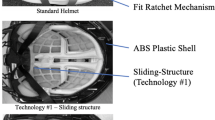Abstract
Although the primary purpose of cycling helmets is crash safety, helmets can also be used to help reduce aerodynamic drag. Commercial helmets differ from one another in their shape, length, mass, frontal area, number of vents, size of vents, shape of vents and location of vents, all of which may play an important role in terms of aerodynamic drag. In this study, the influence of helmet hole configuration and helmet position on the aerodynamic drag for one shape of aero helmet was analysed, to identify the significance of the number and location of ventilation holes. Wind tunnel tests were carried out on a model head with a 3D printed aero helmet with holes that could be blocked to simulate different configurations. In addition the drag was measured for different head angles and different positions of the helmet on the head with all ventilation holes closed. The results showed that head angle and nose-to-helmet distance were more important in determining drag area than the number or position of ventilation holes, with only a slight reduction in aerodynamic drag for a helmet with no ventilation holes compared to multiple, large holes. For an aero helmet, proper helmet fitting is more important than the details of the ventilation holes.











Similar content being viewed by others
References
Grappe F, Candau R, Belli A, Rouillon JD (1997) Aerodynamic drag in field cycling with special reference to the Obree’s position. Ergonomics 40(12):1299–1311
Gibertini G, Campanardi G, Grassi D, Macchi C (2008) Aerodynamics of biker position. In: BBAA VI International Colloquium on Bluff bodies aerodynamics and applications, Milano, Italy
Oggiano L, Leirdal S, Saetran L, Ettema G (2007) Aerodynamic optimization and energy saving of cycling postures for international elite level cyclists. In: The Engineering of sport 7, vol 1, pp 597–604
Brownlie L, Ostafichuk P, Tews E, Muller H, Briggs E, Franks K (2010) The wind-averaged aerodynamic drag of competitive time trial cycling helmets. Procedia Eng 2:2419–2424
Akbarzadeh A, Alam F, Subic A, Watkins S (2007) Effects of venting geometry on thermal comfort and aerodynamic efficiency of bicycle helmets. In: The impact of technology on sport II, Taylor and Francis, p 773
Alam F, Chowdhury H, Elmir Z, Sayogo A, Love J, Subic A (2010) An experimental study of thermal comfort and aerodynamic efficiency of recreational and racing bicycle helmets. Procedia Eng 2:2413–2418
Alam F, Subic A, Watkins S (2006) A study of aerodynamic drag and thermal efficiency of a series of bicycle helmets. In: 6th International Conference on Engineering of Sports, Germany
Blair K, Sidelko S (2008) Aerodynamic performance of cycling time trial helmets. Eng Sport 7:371–377
Chowdhury H, Alam F (2014) An experimental study on aerodynamic performance of time trial bicycle helmets. Sports Eng 17:165–170
Mustary I, Chowdhury H, Loganathan B, Alharthu M, Alam F (2014) Aerodynamic efficiency and thermal comfort of road racing bicycle helmets. In: 19th Australasian Fluid Mechanics Conference, Melbourne, Australia
Van Brecht A, Nuyttens D, Aerts J, Quanten S, De Bruyne G, Berckmans D (2008) Quantification of ventilation characteristics of a helmet. Appl Ergonomics 39:332–341
Underwood L (2012) Aerodynamics of track cycling. In: PhD Thesis, Christchurch, New Zealand
Acknowledgments
The authors would like to thank Dr Patrick Geoghegan and Gerry Kirk for their assistance with the wind tunnel at the University of Canterbury, and Eric Cox for his technical assistance throughout this project.
Author information
Authors and Affiliations
Corresponding author
Rights and permissions
About this article
Cite this article
Underwood, L., Jermy, M., Eloi, P. et al. Helmet position, ventilation holes and drag in cycling. Sports Eng 18, 241–248 (2015). https://doi.org/10.1007/s12283-015-0181-7
Published:
Issue Date:
DOI: https://doi.org/10.1007/s12283-015-0181-7




